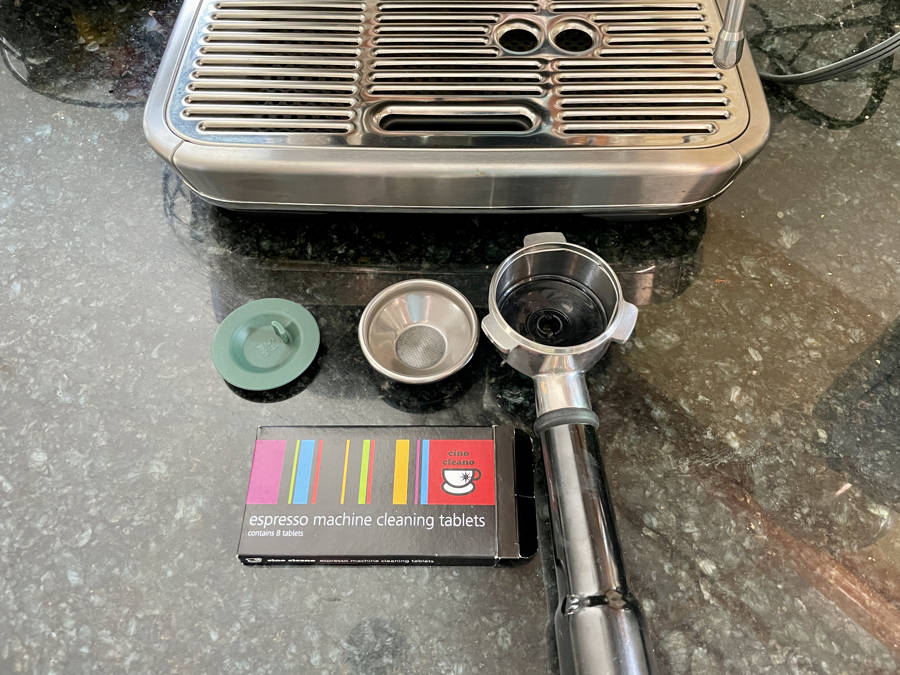When pulling a flavorful espresso shot, most people focus on choosing coffee beans, grinding them to perfection, dosing correctly, tamping, and so on. But, the machine has to be well-maintained as well. Coffee oils build up in the group head after every use. To remove that residue, you need to do a backflush.
Backflushing forces water and cleaner through the group head and coffee machine systems. This removes buildup and keeps the pressure valve in good working condition.
Today, I’ll explain what backflushing is, why you should do it, and give you a step-by-step guide on how to backflush an espresso machine, using Breville Barista pro as a live example.
What is Backflushing?
Backflushing is the process of cleaning the pressure valve. Hot water and detergent are flushed back through the brew group to remove coffee oils and residue buildup from the group, shower screen, the holding plate, and the three-way valve.
Over time, too much coffee residue builds in the machine, which influences the quality and flavor of your espresso. For example, if your machine is full of rancid coffee oils, you’ll have a bitter or rancid espresso. You want to remove the residue through the solenoid valve. This ensures your coffee machine is clean and you have the best espresso flavor.
How To Backflush an Espresso Machine
Here’s what you need to backflush your espresso machine:
- Backflush disc, also called a blind filter
- Espresso machine cleaner
Here’s a step-by-step guide on how to backflush a Breville Barista Pro. This process works on most espresso machines, but check if it has a three-way solenoid valve first (see FAQ later).

1. Prepare the Machine
The first thing to do is prepare your machine. Importantly, empty the drip tray and make sure the water tank is full. This process will completely fill the water tray and use most of the tank.
2. Prepare the Blind Basket
Insert the single-wall filter basket into your portafilter, then place the blind filter inside (this is the disc without any holes in it). The blind basket prevents any water from exiting the portafilter. You can also use a rubber disc that fits over the holes of a single-shot basket.
You should use a single-wall basket as it’s the smallest and best fit for the blind basket. It further minimizes the chance of water coming out of the portafilter.
3. Put the Backflush Cleaner in the Basket
I prefer Cino Cleano backflushing tablets. Each pack has eight tablets, which lasts plenty of time. But, you can get any cleaning tablets you prefer. If you use a cleaning powder, add 3 g, which is about half a teaspoon.

4. Run the Backflush
Next, you should insert and lock the portafilter into the group head and start the brew cycle. After starting the brew cycle, wait for about 20 seconds. This is because the pump is building pressure. If your machine has a brew pressure gauge, you can see the pressure buildup there.
For the Breville Barista Pro, you push the menu button, then choose backflush. You’ll see a timer count down down for the backflush and a smaller number will indicate which cycle it’s on (it does five backflushes total).

When the pressure builds up, you’ll hear a whoosh sound. That’s the cleaner getting blown back into the brew group through the valve.
When the water and cleaner go through the brew group and the valve, they’ll empty into the drip tray. You’ll notice dirty, foamy water in the tray – that’s the backflush water.

Brown foam is normal, and it means the backflush process is working to dissolve oils from the system.
5. Repeat the Process
You should repeat the process until the foamy water comes out clear in the drip tray. This means you’ve gotten all the old beans and oils out of the brew group.
It usually takes about five times, in my experience. The nice thing about the Barista Pro is it does this automatically. Let it keep counting down and running the cycles.
6. Do a Clean Water Backflush
Once your machine is clean, it’s time to do another series of backflushes, but this time with clean water.
Remove the portafilter from the brew head, and rinse out any remaining cleaner while leaving the blind basket in there.

Then, it’s time to do another backflush like before, this time using only water. You need to do this to make sure there’s no cleaner left behind in the machine.
Insert the portafilter again (with just the blind basket), and repeat step four another five times without cleaner. The more cycles you do, the less soapy and clearer the discharge will become. You should have clean water coming out by the fifth cycle.
7. Do a Regular Flush Without the Portafilter
When you’re done, remove the portafilter, and do a flush from the group. Flush it the “normal” way this time to clean out any remaining residue.
Take out the blind filter and return the filter you use for brewing, and you can brew.
Bonus step: Some users like to pull and discard an espresso shot to ensure there aren’t any off-flavors.
You can see a video walkthrough here:
FAQ
How often should you backflush an espresso machine?
According to Breville, you should do a clean water backflush once a day and a detergent backflush once a week. Personally, I think you can backflush every month or two without a problem, and the Barista Pro gives an alert about every 100 cycles.
Are all Espresso Machines capable of being backflushed?
No, not all espresso machines are capable of being backflushed. Only the machines that have a three-way valve can be backflushed. This small valve releases the water pressure after you’re done brewing to protect your machine from being damaged by too much pressure. It deposits the water into the drip tray. You should perform backflushing only on machines that have the three-way valve. Check the owner’s manual if you aren’t sure. Also, some high-end espresso machines have automatic backflush, which you can start with a push of a button.
Should You Backflush Your Coffee Machine?
You should backflush your machine at least once a week to ensure buildup doesn’t sour your espresso. Luckily, it’s easy to do. All you need is a blind filter and backflushing detergent, and run some cycles through the loaded portafilter.
Keeping your machine working properly requires more than backflushing. You need to clean the portafilters, flush the group head, descale, and more. Check out our guide on cleaning an espresso machine, to make sure you’re always pulling the best espresso.




